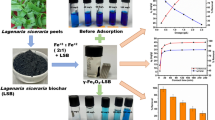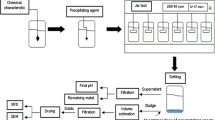Abstract
Microbiocides are used to control problematic microorganisms. High doses of microbiocides cause environmental and operational problems. Therefore, using microbiocide enhancers to make microbiocides more efficacious is highly desirable. 2,2-dibromo-3-nitrilopropionamide (DBNPA) is a popular biodegradable microbiocide. d-Amino acids have been used in lab tests to enhance microbiocides to treat microbial biofilms. In this investigation, d-tyrosine was used to enhance DBNPA against Desulfovibrio vulgaris biofilm on C1018 carbon steel. After 7 days of incubation, the mass loss of coupons without treatment chemicals in the ATCC 1249 culture medium was found to be 3.1 ± 0.1 mg/cm2. With 150 ppm (w/w) DBNPA in the culture medium, the mass loss was reduced to 1.9 ± 0.1 mg/cm2 accompanied by a 1-log reduction in the sessile cell count. The 150 ppm DBNPA + 1 ppm d-tyrosine combination attained an extra 3-log reduction in sessile cell count and an additional 30% reduction in mass loss compared with 150 ppm DBNPA only treatment. The combination also led to a smaller maximum pit depth. Linear polarization resistance (LPR), electrochemical impedance spectrometry (EIS), and potentiodynamic polarization (PDP) tests corroborated the enhancement effects.











Similar content being viewed by others
References
ASTM-G1-03 (2011) Standard practice for preparing, cleaning, and evaluating corrosion test specimens
Cwalina B, Dec W, Michalska JK, Jaworska-Kik M, Student S (2017) Initial stage of the biofilm formation on the NiTi and Ti6Al4V surface by the sulphur-oxidizing bacteria and sulphate-reducing bacteria. J Mater Sci Mater Med 28:173
Gu T, Jia R, Unsal T, Xu D (2019) Toward a better understanding of microbiologically influenced corrosion caused by sulfate reducing bacteria. J Mater Sci Technol 35:631–636
Ilhan-Sungur E, Unsal-Istek T, Cansever N (2015) Microbiologically influenced corrosion of galvanized steel by Desulfovibrio sp. and Desulfosporosinus sp. in the presence of Ag–Cu ions. Mater Chem Phys 162:839–851
Jia R, Yang D, Li Y et al (2017a) Mitigation of the Desulfovibrio vulgaris biofilm using alkyldimethylbenzylammonium chloride enhanced by d-amino acids. Int Biodeter Biodegr 117:97–104
Jia R, Yang D, Xu D, Gu T (2017b) Mitigation of a nitrate reducing Pseudomonas aeruginosa biofilm and anaerobic biocorrosion using ciprofloxacin enhanced by d-tyrosine. Sci Rep 7:6946
Jia R, Yang D, Xu D, Gu T (2017c) Anaerobic corrosion of 304 stainless steel caused by the Pseudomonas aeruginosa biofilm. Front Microbiol 8:2335
Jia R, Yang D, Abd Rahman HB, Gu T (2018a) An enhanced oil recovery polymer promoted microbial growth and accelerated microbiologically influenced corrosion against carbon steel. Corros Sci 139:301–308
Jia R, Yang D, Xu D, Gu T (2018b) Carbon steel biocorrosion at 80 °C by a thermophilic sulfate reducing archaeon biofilm provides evidence for its utilization of elemental iron as electron donor through extracellular electron transfer. Corros Sci 145:47–54
Jia R, Wang D, Jin P et al (2019) Effects of ferrous ion concentration on microbiologically influenced corrosion of carbon steel by sulfate reducing bacterium Desulfovibrio vulgaris. Corros Sci 153:127–137
Li SY, Kim YG, Jeon KS et al (2001) Microbiologically influenced corrosion of carbon steel exposed to anaerobic soil. Corrosion 57:815–828
Li H, Xu D, Li Y et al (2015) Extracellular electron transfer is a bottleneck in the microbiologically influenced corrosion of C1018 carbon steel by the biofilm of sulfate-reducing bacterium Desulfovibrio vulgaris. PLoS ONE 10:e0136183
Liu X, Li Z, Fan Y et al (2020) A mixture of d-amino acids enhances the biocidal efficacy of CMIT/MIT against corrosive Vibrio harveyi biofilm. Front Microbiol 11:557435
Marsili E, Baron DB, Shikhare ID et al (2008) Shewanella secretes flavins that mediate extracellular electron transfer. Proc Natl Acad Sci 105:3968–3973
Mukhopadhyay A, He Z, Alm EJ et al (2006) Salt Stress in Desulfovibrio vulgaris Hildenborough: an integrated genomics approach. J Bacteriol 188:4068–4078
Siddiqui A, Pinel I, Prest EI et al (2017) Application of DBNPA dosage for biofouling control in spiral wound membrane systems. Desalin Water Treat 68:12–22
Tan JL, Goh PC, Blackwood DJ (2017) Influence of H2S-producing chemical species in culture medium and energy source starvation on carbon steel corrosion caused by methanogens. Corros Sci 119:102–111
Thauer RK, Stackebrandt E, Hamilton WA (2007) Energy metabolism and phylogenetic diversity of sulphate-reducing bacteria. In: Barton LL, Hamilton WA (eds) Sulphate-reducing bacteria. Cambridge University Press, Cambridge, pp 1–38
Tschech A, Schink B (1986) Fermentative degradation of monohydroxybenzoates by defined syntrophic cocultures. Arch Microbiol 145:396–402
Unsal T, Jia R, Kumseranee S et al (2019) Laboratory investigation of microbiologically influenced corrosion of carbon steel in hydrotest using enriched artificial seawater inoculated with an oilfield biofilm consortium. Eng Fail Anal 100:544–555
Videla HA (2002) Prevention and control of biocorrosion. Inter Biodeter Biodegr 49:259–270
Wang D, Liu J, Jia R, Dou W, Kumseranee S, Punpruk S, Gu T, Li X (2020) Distinguishing two different microbiologically influenced corrosion (MIC) mechanisms using an electron mediator and hydrogen vvolution detection. Corros Sci 177:108993
Xu D, Gu T (2014) Carbon source starvation triggered more aggressive corrosion against carbon steel by the Desulfovibrio vulgaris biofilm. Inter Biodeter Biodegr 91:74–81
Xu D, Li Y, Gu T (2012) A synergistic d-tyrosine and tetrakis hydroxymethyl phosphonium sulfate biocide combination for the mitigation of an SRB biofilm. World J Microbiol Biotechnol 28:3067–3074
Xu D, Li Y, Gu T (2016) Mechanistic modeling of biocorrosion caused by biofilms of sulfate reducing bacteria and acid producing bacteria. Bioelectrochemistry 110:52–58
Acknowledgements
This project was financed by PTT Exploration and Production, Thailand. T. Unsal was funded by The Scientific and Technological Research Council of Turkey (TUBITAK-2219). Parts of this work were from Corrosion/2020 Conference Paper 2020-14527 with permission.
Author information
Authors and Affiliations
Corresponding author
Ethics declarations
Conflict of interest
The authors declare that they have no conflict of interests.
Additional information
Publisher's Note
Springer Nature remains neutral with regard to jurisdictional claims in published maps and institutional affiliations.
Rights and permissions
About this article
Cite this article
Unsal, T., Wang, D., Kumseranee, S. et al. d-Tyrosine enhancement of microbiocide mitigation of carbon steel corrosion by a sulfate reducing bacterium biofilm. World J Microbiol Biotechnol 37, 103 (2021). https://doi.org/10.1007/s11274-021-03072-9
Received:
Accepted:
Published:
DOI: https://doi.org/10.1007/s11274-021-03072-9




